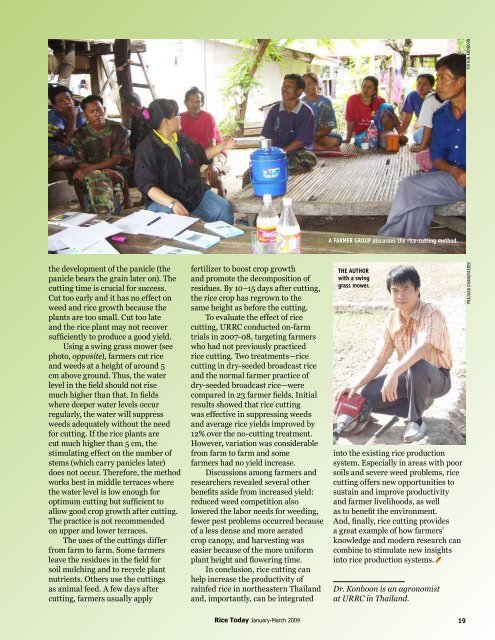How much water does rice need? - adron.sr
How much water does rice need? - adron.sr
How much water does rice need? - adron.sr
Create successful ePaper yourself
Turn your PDF publications into a flip-book with our unique Google optimized e-Paper software.
yothin konboonA FARMER GROUP discusses the <strong>rice</strong>-cutting method.the development of the panicle (thepanicle bears the grain later on). Thecutting time is crucial for success.Cut too early and it has no effect onweed and <strong>rice</strong> growth because theplants are too small. Cut too lateand the <strong>rice</strong> plant may not recoversufficiently to produce a good yield.Using a swing grass mower (seephoto, opposite), farmers cut <strong>rice</strong>and weeds at a height of around 5cm above ground. Thus, the <strong>water</strong>level in the field should not rise<strong>much</strong> higher than that. In fieldswhere deeper <strong>water</strong> levels occurregularly, the <strong>water</strong> will suppressweeds adequately without the <strong>need</strong>for cutting. If the <strong>rice</strong> plants arecut <strong>much</strong> higher than 5 cm, thestimulating effect on the number ofstems (which carry panicles later)<strong>does</strong> not occur. Therefore, the methodworks best in middle terraces wherethe <strong>water</strong> level is low enough foroptimum cutting but sufficient toallow good crop growth after cutting.The practice is not recommendedon upper and lower terraces.The uses of the cuttings differfrom farm to farm. Some farmersleave the residues in the field forsoil mulching and to recycle plantnutrients. Others use the cuttingsas animal feed. A few days aftercutting, farmers usually applyfertilizer to boost crop growthand promote the decomposition ofresidues. By 10–15 days after cutting,the <strong>rice</strong> crop has regrown to thesame height as before the cutting.To evaluate the effect of <strong>rice</strong>cutting, URRC conducted on-farmtrials in 2007-08, targeting farmerswho had not previously practiced<strong>rice</strong> cutting. Two treatments—<strong>rice</strong>cutting in dry-seeded broadcast <strong>rice</strong>and the normal farmer practice ofdry-seeded broadcast <strong>rice</strong>—werecompared in 23 farmer fields. Initialresults showed that <strong>rice</strong> cuttingwas effective in suppressing weedsand average <strong>rice</strong> yields improved by12% over the no-cutting treatment.<strong>How</strong>ever, variation was considerablefrom farm to farm and somefarmers had no yield increase.Discussions among farmers andresearchers revealed several otherbenefits aside from increased yield:reduced weed competition alsolowered the labor <strong>need</strong>s for weeding,fewer pest problems occurred becauseof a less dense and more aeratedcrop canopy, and harvesting waseasier because of the more uniformplant height and flowering time.In conclusion, <strong>rice</strong> cutting canhelp increase the productivity ofrainfed <strong>rice</strong> in northeastern Thailandand, importantly, can be integratedTHE AUTHORwith a swinggrass mower.into the existing <strong>rice</strong> productionsystem. Especially in areas with poorsoils and severe weed problems, <strong>rice</strong>cutting offers new opportunities tosustain and improve productivityand farmer livelihoods, as wellas to benefit the environment.And, finally, <strong>rice</strong> cutting providesa great example of how farmers’knowledge and modern research cancombine to stimulate new insightsinto <strong>rice</strong> production systems.Dr. Konboon is an agronomistat URRC in Thailand.prajuab duangpakdeeRice Today January-March 2009 19

















